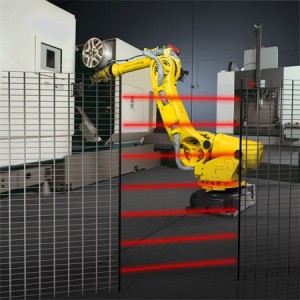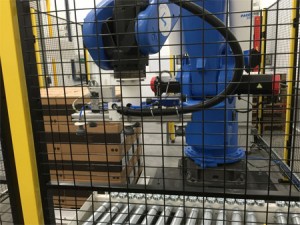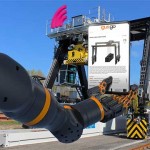Food factory cobots are coming… or are they?
 Advancements in collaborative robots, or cobots, are creating a bit of a buzz in manufacturing and the way humans and robots interact safely alongside each other. Yet, food processing, packaging and palletising lines remain largely cobot-free zones. Paul Wilkinson, commercial and information systems manager at Pacepacker Services explains why cobots, which currently account for an estimated 5% share of the robot market, aren’t always the answer for every application.
Advancements in collaborative robots, or cobots, are creating a bit of a buzz in manufacturing and the way humans and robots interact safely alongside each other. Yet, food processing, packaging and palletising lines remain largely cobot-free zones. Paul Wilkinson, commercial and information systems manager at Pacepacker Services explains why cobots, which currently account for an estimated 5% share of the robot market, aren’t always the answer for every application.
Several respected market commentators have speculated that the cobot sector will grow by 50% year-on-year, reaching $1bn in 2020. The majority of this growth will be driven by uptake in automotive assembly, electronic parts assembly and medical device manufacturing applications. Thanks to safety and sensing technologies, these cage-free cobots can work side by side with humans on shared or separate tasks.
However, the opportunities in food processing or packing lines may be limited by speed, while payload could prove a challenge for cobots assigned to palletising tasks. Paul explains: “Right now industrial cobots are, by their very nature, small and agile. Although beneficial in a number of manufacturing settings, this can limit their usefulness in food factories.
“To minimise the risk of injury to humans, cobots generally work at much slower speeds than conventional robots. This means a cobot may not achieve comparable product handling pick and place speeds. Meanwhile, in palletising tasks, the weight that can be lifted may prove challenging for all but the strongest cobots. But we must remember that it’s early days for cobots. What’s more, a human/robot collaborative operation can still be accomplished even with the most conventional industrial robots.”
Addressing workforce safety grey areas
Each year around over 5000 injuries in food and drink manufacturing industries are reported to the Health and Safety Executive (HSE), representing about a quarter of all manufacturing injuries.
Food production is especially fast paced. Workplace safety is forever evolving and for repetitive and strenuous tasks like manual product handling and packing, robots can address some of the key causes of human injuries. “When it comes to safety, you are ultimately reliant on people understanding and following the rules. Equally, safety risks will vary depending on your chosen robot and application,” highlights Paul.
 Robotic work cells and plant layouts evolve quickly. This means that the risks can change rapidly too, so it’s advisable to regularly schedule a review of your safety policies. Contrary to popular belief, installing a cobot doesn’t eliminate workplace risk assessments. In fact, the ISO/TS 15066 safety standard introduced for cobots in March 2016 means that a comprehensive risk assessment is still required for both the robot and peripheral equipment.
Robotic work cells and plant layouts evolve quickly. This means that the risks can change rapidly too, so it’s advisable to regularly schedule a review of your safety policies. Contrary to popular belief, installing a cobot doesn’t eliminate workplace risk assessments. In fact, the ISO/TS 15066 safety standard introduced for cobots in March 2016 means that a comprehensive risk assessment is still required for both the robot and peripheral equipment.
“It must be noted that there are different degrees of collaboration and there are safe ways of introducing robot-human collaboration,” Paul emphasises. “A fully-caged, perimeter guarded robot at the end of the line isn’t always necessary, although may be warranted for heavy duty palletising operations.”
Adding virtual fencing software is one way to bring physical safety guards down and protect your workforce from automation hazards. Providing safety zones are not breached the robot operates at a normal speed. With this sensing software, the robot can be programmed with different ‘reactions’ for different zones and scenarios. For example, it can be programmed to perform an emergency stop when necessary or to alter its speed according to operator proximity.
Fenceless robot cells also facilitate quicker access for performing maintenance and part changeover tasks, notes Paul. “In contrast, shutting down a fully guarded system could result in considerable production downtime, more product waste and requires skilled engineering operatives, which may not be available in-house.”
The number of industrial robots deployed worldwide is expected to increase to around 2.6 million units by 2019 according to the 2016 World Robotics Report published by the International Federation of Robotics (IFR). If the commentators are correct, cobots could account for a large chunk of these sales. Yet, like other forms of automation, deployment of cobots within the food sector may be slower to emerge than other manufacturing industries. “Collaboration between humans and machines will be a key driver for future technological trends,” adds Paul. “In time, cobots may very well become the mainstay in food production too.”
Visit the Pacepacker Services website for more information
See all stories for Pacepacker Services















